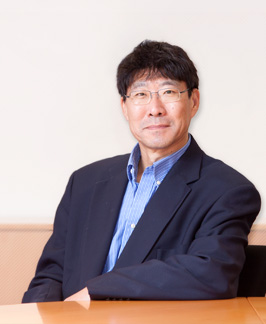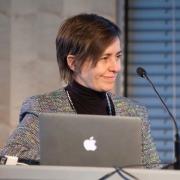
CCF CAD/Graphics 2021
2021/05/15~2021/05/16
Xi'an China
208119views participants
自定义模块
更多|
Recent Progress in Material-aware Design Helmut Pottmann, Professor, King Abdullah University of Science and Technology. |
 |
| Abstract
Geometric modeling and computational design as a pure shape generation process may lead to long and costly product development cycles due to feedback loops between design, engineering, fabrication. Thus we recently see a trend towards novel modeling tools which incorporate essential aspects of function, materials and fabrication into the early shape design phase.In this talk the speaker will focus on material-aware design with materials such as sheet metal or glass. However, these two materials have to be treated in quite different ways: Sheet metal, as well as paper and certain plastics, are easily deformed in an isometric way. Hence, it is sufficient to come up with an efficient way of dealing with isometric deformations. For that, we propose a very simple and effective quad-mesh based method. Cold bending of glass is a more subtle topic, highly relevant as a cost-efficient method for realizing doubly curved glass facades. However, the performance of the required simulations is not suitable for near-interactive digital modeling tools. This and the presence of multiple equilibrium states for certain boundary conditions lead to an approach based on a mixture density network trained from more than a million simulations. Our model is capable of handling multi-stable configurations and accurately predicts equilibrium shapes and corresponding maximal stresses. The results have been validated with a physical realization of a cold bent glass surface. Bio Helmut Pottmann is a professor of AMCS and CS at KAUST and founding director of the Visual Computing Center (formerly Geometric Modeling and Scientific Visualization Center). He has had faculty positions in the US and in Germany and has been a Professor of Applied geometry at TU Vienna since 1992. His research interests are in Applied Geometry, Visual Computing and most recently in Geometric Computing for Architecture and Manufacturing. He is a Fellow of SIAM and received a number of awards including the Eurographics Outstanding Technical Contributions Award, the Bezier Award of the Solid Modeling Association and the John Gregory Award for fundamental contributions to geometric modeling. |
|
自定义模块
更多|
On Reconstructing 3D Thin Structures
Wenping Wang, Professor, Texas A&M Uinversity. |
 |
|
|
Abstract
Thin structures are ubiquitous, such as ropes, cables, tree branches, wire arts, and wire-frame furniture. It is well known that 3D thin structures are challenging to reconstruct due to their narrow width and lack of distinct features. However, their reconstruction has received relatively little research attention. Clearly, the detection and reconstruction of these thin objects have many applications in computer graphics, computer vision, and robotics. In this talk I will present our recent works on reconstructing 3D thin structures from images, depth maps, and videos. Then I will analyze the limitations of the existing methods and discuss outstanding issues that need to be tackled in order to achieve real-time reconstruction of thin structures in the wild. Bio Dr. Wenping Wang is Professor and Head of the Department of Visualization at Texas A&M University. His research interests cover computer graphics, computer visualization, computer vision, robotics, medical image processing, and geometric computing, and he has published over 160 journal papers in these fields. He is or has been journal associate editor of several international journals, including Computer Aided Geometric Design (CAGD), Computer Graphics Forum (CGF), IEEE Transactions on Computers, and IEEE Computer Graphics and Applications, and has chaired a number of international conferences, including Pacific Graphics 2012, ACM Symposium on Physical and Solid Modeling (SPM) 2013, SIGGRAPH Asia 2013, and Geometry Summit in 2019. Prof. Wang received the John Gregory Memorial Award for contributions in geometric modeling. He is an IEEE Fellow. |
||
自定义模块
更多|
Computational Conformal Geometry for Quadrilateral and Hexahedral Mesh Generation
Xianfeng David Gu , SUNY Empire Innovation Professor |
 |
|
|
Abstract
Structured hexahedral mesh generation is called "Holy Grail" in CAD and CAE fields to reflect its fundamental importance and intrinsic difficulty. In this talk, we introduce a novel approach for quadrilateral and hexahedral mesh generation based on conformal geometry. A quadrilateral mesh naturally induces a conformal structure and a meromorphic quartic differential, the singularities form the divisor of the differential. By the theory of characteristic classes of holomorphic line bundles, the singularities satisfy the Abel-Jacobi condition. Once the singularities are determined, a conformal flat metric can be obtained using surface Ricci flow., which induces the trajectories of the quadratic differential. The trajectories form the quadrilateral mesh. Furthermore, the critical trajectory partitions the surface in a canonical way, and decomposes the interior volume into solid cylinders. Therefore, the quad-mesh can be extended to the interior to form the hex-mesh. This work lays down the theoretical foundation for structured quad and hex mesh generation, and discovers the profound connection between holy grail problem with conformal geometry. It has great potential to tackle more general problems in CAD and CAE fields. Bio
Dr. Xianfeng Gu got his bachelor degree from Computer Science Department, Tsinghua University; his master degree and PhD from Harvard University, supervised by the Fields medalist, Prof. Shing-Tung Yau. Dr. Gu currently is the empire innovation professor in the Computer Science Department and Applied Mathematics Department, State University of New York at Stony Brook. Dr. Gu is also affiliated with Center of Mathematical Sciences and Applications, Harvard University and Yau's Center of Mathematics, Tsinghua University. Collaborated with Prof. Yau and other scholars, Dr. Gu has founded an interdisciplinary field “Computational Conformal Geometry", which applies modern topology and geometry theories in engineering and medical fields. Dr. Gu has won many awards, including NSF CAREER award, NSFC outstanding off sea scholar, Morningside gold medal for applied mathematics and so on. |
||
自定义模块
更多|
The Role of Geometry in Intelligent Cities of Tomorrow Michela Spagnuolo , Istutyto di Matematica Applicata e Tecnologie Informatiche "E.Magenes" , Consiglio Nazionale delle Ricerche |
 |
|
|
Abstract
The concerns for a sustainable future have a strong impact on, and are influenced by, the growth of urban areas and how these will be able to address fundamental issues such as energy production and resource consumption, healthy life and well-being, biodiversity loss in their borders, and economic development. The ability to predict, test and evaluate different urban management strategies is therefore becoming an important asset, enabled by the quickly evolving technologies that shape the concept of Smart City such as IoT, HPC/cloud computing and fast telecommunication channels. In this context, modeling and simulation are likely to play a key role for the development of so-called “digital twins” of complex urban scenarios that may facilitate understanding the relevance of the re-thinking urban management and planning with advanced digital approaches. Digital data about cities are nowadays ubiquitous, coming from laser or photogrammetric acquisition methods, and methods for 3D reconstructions of urban scenes have been studied since decades by now. But what are the models needed to represent geometries occurring in complex urban areas? What kind of geometric models are needed and how should these be conceived to support the transition from smart to intelligent urban models? Bio
Dr Michela Spagnuolo is Research Director and Director of the Institute of Applied Mathematics and Information Technologies "E. Magenes "(IMATI). Her scientific activity deals with the study and development of geometric and topological methods for the representation, comparison and characterization of surfaces and volumes. She authored more than 160 peer-reviewed scientific papers, one book on mathematical methods for the shape analysis, and edited several special issues and books on the topics of shape analysis and modelling. She’s currently associate editor of international journals, and chaired several conferences, including Eurographics 2019 and Shape Modelling International.In 2014 she was elected Fellow of EUROGRAPHICS, and serves in the executive committee of the same association. |
||